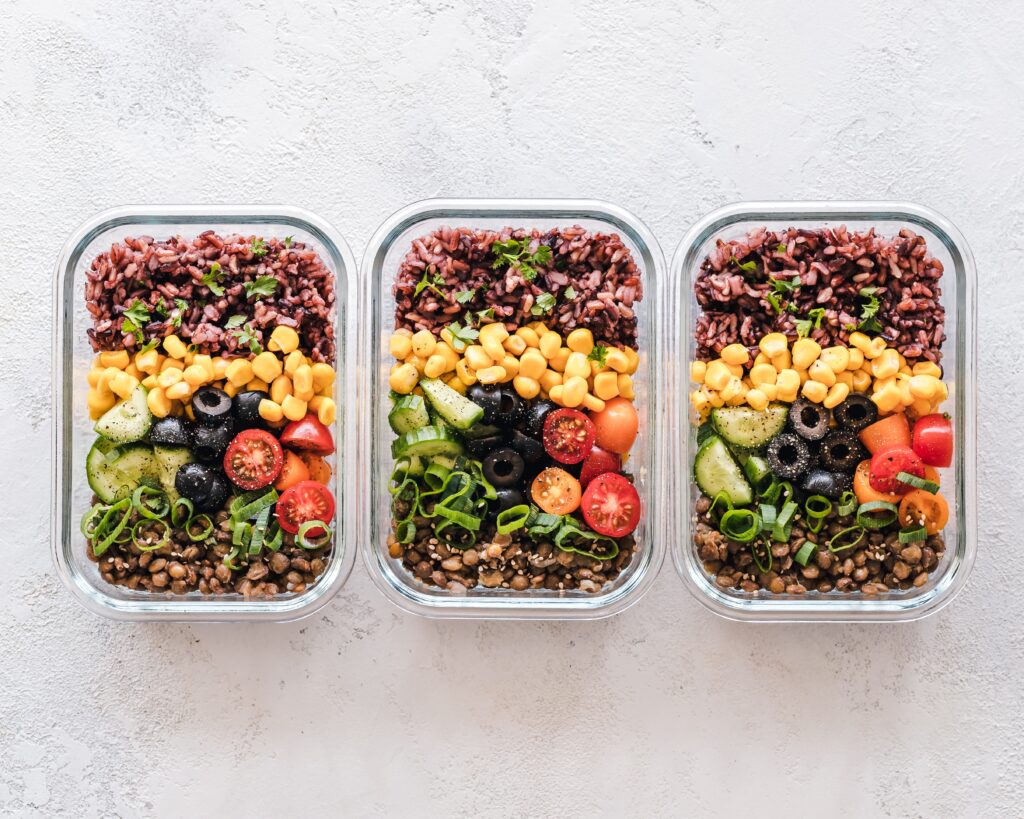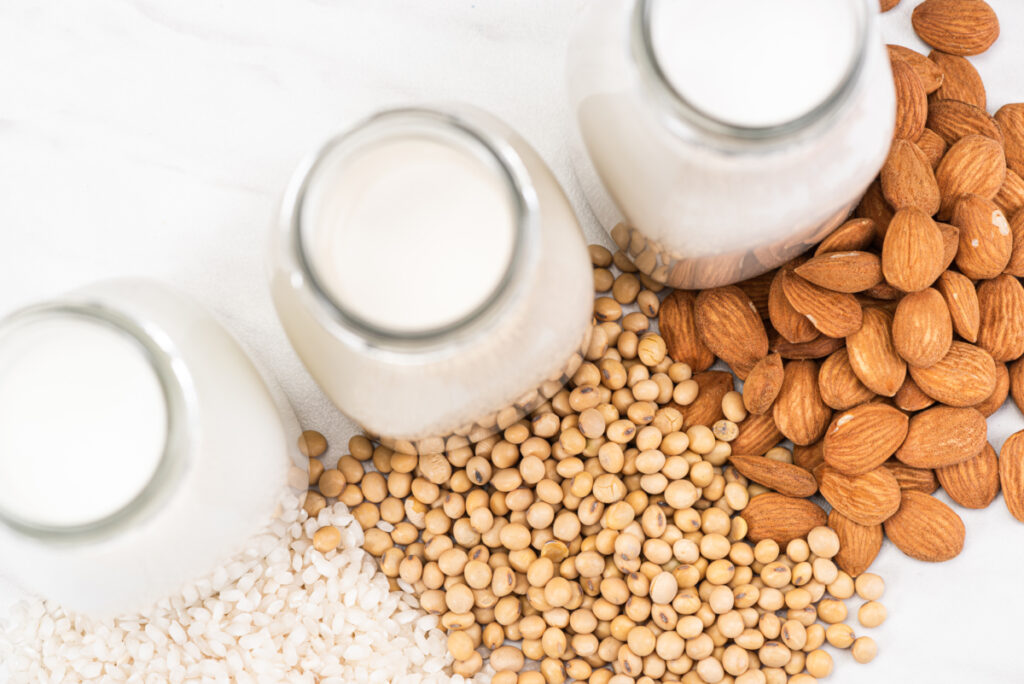Driven by the climate crisis, ethical concerns, and personal health considerations, plant-based diets are on the rise worldwide. Approximately 3% of the British public now identify as vegan, with 63% of Britain’s vegans having adopted the lifestyle in the last five years.¹ However, a rise in plant-based eating is not limited to vegan diets.
Plant-based milk is one example of a vegan-friendly alternative becoming a mainstream choice for a diverse range of consumers – not just those who follow a plant-based diet. Continuing to gain popularity throughout 2022, the global vegan milk market is expected to hit $123 billion by 2030.² Meanwhile, approximately half of the British population is either cutting down or cutting meat out completely from their diet.³ As such, the plant-based food industry is continually looking for ways to create products that meet consumer demands for texture and taste.
However, flavour is a key limiting factor in the acceptability of plant-based food alternatives.⁴ Therefore, to meet the growing demand for plant-based substitutes, food manufacturers must focus on developing alternatives with an agreeable taste profile. Flavour-masking ingredients are a popular way to disguise unwanted flavours and enhance desirable characteristics. So, by leveraging these convenient ingredients, manufacturers now have an arsenal of tools at their disposal to amplify the sensory perception and marketability of plant-based foods, rocketing their potential to the next level.

What’s the Hype about Plant-Based?
Climate change is a key driving factor for consumers looking to cut down on their consumption of animal-based food products. The production of meat, particularly beef, is associated with extremely high greenhouse gas emissions and land usage, as well as substantial soil acidification and water consumption.⁵ By providing an alternative to animal-based food products, plant-based foods have the potential to help reduce these environmental impacts: studies estimate that following a plant-based diet can reduce an individual’s carbon footprint by up to 73%.¹ ⁶
Another key consideration to introducing more plant-based foods into our diets is the associated health benefits. Animal-based food products such as red meat and cheese are high in saturated fats, which have been known to lead to an increased risk of heart and circulatory diseases.⁷ Studies show that consuming plant-based alternatives can lead to lower cholesterol and blood pressure, reducing the likelihood of developing a range of conditions including diabetes, heart disease, and even some cancers.⁷ Both the environmental and health benefits associated with a switch to more plant-based foods strongly demonstrate the rapid growth in this sector of the food industry.
A Growing Market
The global vegan food market is expanding exponentially. By 2026, it is expected to exceed $24 billion, with businesses rushing to capitalise on the growing demand for plant-based products.⁸ In addition to the environmental and health benefits, plant-based alternatives are also becoming associated with a particular ‘image’. Brands are now combining health-based and environmental messaging with innovative design to create a ‘fashionable’ identity for their plant-based products. One example of this is the Swedish brand, Oatly. Their successful branding is widely credited with a significant boost to the popularity of its oat milk.⁸ Furthermore, in a market offering increasing numbers of visually distinctive vegan products, choosing a specific type of plant-based milk – in a coffee shop for example – has almost become a matter of personal identity.⁹

But, while the data shows us that plant-based food alternatives offer huge environmental benefits, growing the necessary crops is a demanding process requiring large areas of land. Moreover, the extensive use of water, energy-intensive fertilizer, pesticides, and tractor fuel is also needed to yield sufficient produce.¹⁰ As plant-based foods grow in popularity, the industry must therefore continually re-evaluate its methods in order to maintain food security and ensure sustainable production. Looking ahead, it will be vital for food producers to adopt innovative methods of production that uphold sustainability targets while still maintaining high-quality, tasty products for consumers.
Flavour Challenges in Plant-Based Food Alternatives
Despite their increased popularity, plant-based food alternatives continue to present a range of challenges for food manufacturers. Creating products with sufficient levels of protein has historically been the main challenge for meat analogues;¹¹ however, undesirable flavours and textures consistently present a significant barrier to wider consumer acceptability. For those looking to switch out steak for seitan on just a few nights a week, it’s essential that the plant-based meat substitutes on the market closely mimic traditional animal-based foods in both taste and texture.

Over the years, a range of undesirable sensory perceptions has commonly been associated with plant proteins and the products that contain them. These include bitter taste, astringency, and a ‘beany’ flavour.⁴ Similarly, plant-based dairy substitutes, such as plant-based milk, yoghurt, and cream, often display unacceptable sensory properties, including an acidic taste and nutty, ‘paint-like’ flavour.¹²
Several complex strategies have been developed to reduce bitter flavours in plant ingredients, including enzymatic modifications of proteins, the use of fermentation processes to enhance ‘umami’ flavours, and soaking or heat treatments.⁴ ¹³ Alternatively, a more common strategy is utilising flavour agents that can mask undesirable notes. By leveraging these ingredients, manufacturers can enhance the sensory profile of their plant-based food alternatives, leading to wider consumer acceptability.⁴
One example of companies working in this space is Cornelius’ partner, Nielsen-Massey, who specialises in vanilla and flavourings. Naturally derived and allergen-free, their extracts and flavourings can be incorporated into a wide range of plant-based foods. Although vanilla is traditionally used in desserts and sweet foods to enhance taste and sensation, it can also be used to modulate the taste of savoury ingredients. Due to its heat resilience, pure vanilla extract can provide the most flavour stability in roasting and can be used to mask the ‘beany’ flavour associated with some plant-based meat substitutes. Alternatively, vanilla paste is better suited to achieve a creamy flavour profile, commonly associated with desserts; however, it can also be applied as a glaze for meat substitutes when grilling

By working alongside producers of high-quality flavour-modulating ingredients, plant-based food manufacturers can ensure that they can continually provide products that satisfy consumer wants and needs.
To ensure that the industry can continue to meet the demand to produce appetising plant-based analogues, it is also crucial to explore the innovative options at their disposal.
What are Flavonoids?
‘Flavonoid’ is the name used to refer to a group of non-volatile, taste-active compounds (flavonols, flavones, flavanones, isoflavones, anthocyanidins, and flavanols) that are a common component of plant ingredients.⁴ Flavonoids are naturally occurring and can be found in a range of fruits and vegetables as well as in tea, wine, and chocolate.¹⁴ They carry out a number of important processes in the body, including helping to regulate cellular activity, reducing inflammation, and acting as an antioxidant.¹⁴
As a result of these properties, flavonoids also make effective taste modifiers. The method of adding flavourings and other additives to improve taste has raised concerns over nutrition and food safety.⁴ However, flavonoids are naturally derived and can even offer positive health benefits, meaning that their use as flavouring agents can help to increase customer confidence in products containing flavonoids.
HTBA, a partner of Cornelius, is a global leader in natural flavonoid ingredients based in Barcelona, Spain. Their Taste Transparency Toolbox provides transparent solutions for a range of applications, delivering the original taste experience. Their solutions are effective in reducing the astringency, bitterness and metallic notes that can often be found in plant proteins.¹⁵ They can also be used to enhance the sweetness profile of plant-based beverages. By amplifying flavour and boosting sensory perception, flavonoid taste modifiers can become a powerful tool to enhance the taste and overall acceptability of plant-based food.
The Future of Flavour
Climate change is having – and will continue to have – an impact on the food we source. Current research suggests that global warming is changing the taste of key crops.¹⁶ As temperatures rise, heat and drought will affect plant quality, with the increased susceptibility to disease resulting in lower yields and changes to plant texture and taste.¹⁶ Crucially, the nutritional value of crops is also predicted to decrease. Plants use nitrogen to make proteins that are essential to human health; however, high carbon dioxide levels have been found to inhibit plants’ assimilation of nitrate in their leaves, resulting in inhibited protein production.¹⁷ As the levels of CO₂ continue to increase in the coming years, the amount of protein available to humans through the consumption of plants is therefore likely to significantly drop.¹⁷

Consequently, there may be a greater reliance on nutraceuticals and functional foods to supplement our diets in the future. These types of products are already becoming popular among athletes and those interested in health and sports nutrition. With the potential for resources to deplete and the general public looking to get nutritious and filling meals quickly and conveniently, the demand for dietary supplements of this kind is sure to grow over the coming years.
Furthermore, it will also become crucial to adopt an innovative approach to food growth and production moving forward. Methods such as vertical farming maximise growth space while reducing the need for destructive methods such as deforestation. Additionally, vertical farming offers the opportunity to change taste using synthetic lighting; leveraging different wavelengths of light can activate a plant’s primary and secondary metabolism, resulting in enhanced flavour and nutrient content.¹⁸ Other more traditional methods such as crossbreeding of crops to introduce beneficial traits may also become more prevalent.
As the plant-based food market continues to expand and evolve, innovators will have to find new ways to improve flavour. There is further potential for the nutritional properties of plant-based alternatives to be improved using advanced processing techniques and technological interventions, such as the use of enzymes and ultra-high-pressure homogenisation.¹⁹ Alternatively, innovative technological methods such as 3D printing have shown potential in improving plant-based substitutes’ texture and flavour profiles.²⁰
Working towards a more sustainable world
Plant-based food substitutes offer a range of environmental and health advantages. However, as the plant-based food market expands and climate pressures grow, innovators in the food manufacturing industry must continue to develop effective flavour and texture modifiers to maximise the sensory profile of plant-based food substitutes.
At Cornelius, we work with our partners to provide sustainable plant-based flavourings and ingredients, which provide consumers with a wide variety of sustainable options and will help pave the way towards a greener, healthier, and more sustainable future.
References
- 1. Viva! The Vegan Charity. (2023). Statistics about veganism. [Online]. Viva! The Vegan Charity. Available at: https://viva.org.uk/lifestyle/statistics-about-veganism/ [Accessed April 2023].
- Starostinetskaya, A. (2023). Why 2022 Was Oat Milk’s Biggest Year Yet. [Online]. Veg News. Available at: https://vegnews.com/2023/1/2022-oat-milk-biggest-year [Accessed April 2023].
- Rama, K. (2022). Half of Brits limit their meat intake or don’t eat meat – as processed meat sales shrink back. [Online]. Mintel. Available at: https://www.mintel.com/press-centre/half-of-brits-limit-their-meat-intake-or-dont-eat-meat-as-processed-meat-sales-shrink-back/ [Accessed April 2023].
- Wang, Y. et al (2022). Flavour challenges in extruded plant-based meat alternatives: A review. Comprehensive Reviews in Food Science and Food Safety. 21. 2898-2929. https://doi.org/10.1111/1541-4337.12964 [Accessed Aril 2023].
- Poore, J. and Nemecek, T. (2018). Reducing food’s environmental impacts through producers and consumers. Science. 350. 987-992. https://doi.org/10.1126/science.aaq0216 [Accessed April 2023].
- 6. Petter, O. (2020). Veganism is ‘single biggest way’ to reduce our environmental impact, study finds. [Online]. Independent. Available at: https://www.independent.co.uk/life-style/health-and-families/veganism-environmental-impact-planet-reduced-plant-based-diet-humans-study-a8378631.html [Accessed April 2023].
- 7. Hennessey, N. (2022). Is going vegan good for you? [Online]. Bupa. Available at: https://www.bupa.co.uk/newsroom/ourviews/veganism [Accessed April 2023].
- 8. Anthony, A. (2021). From fringe to mainstream: how millions got a taste for going vegan. [Online]. The Guardian. Available at: https://www.theguardian.com/lifeandstyle/2021/oct/10/from-fringe-to-mainstream-how-millions-got-a-taste-for-going-vegan [Accessed April 2023].
- 9. Hale, M. (2021). Exploring the Growth of Plant-Based Milk. [Online]. Food Manufacturing. Available at: https://www.foodmanufacturing.com/consumer-trends/article/21723117/exploring-the-growth-of-plantbased-milk [Accessed April 2023].
- 10. Holmes, B. (2022). Veganism Might Not Be the Most Sustainable Diet. [Online]. The Atlantic. Available at: https://www.theatlantic.com/science/archive/2022/08/meat-veganism-climate-change-agriculture-environment/671200/ [Accessed April 2023].
- 11. Huang, M. et al. (2022). Use of food carbohydrates towards the innovation of plant-based meat analogs. Trends in Food Science & Technology. 129. 155-163. https://doi.org/10.1016/j.tifs.2022.09.021 [Accessed April 2023].
- 12. Jaeger, S. R. et al. (2023). Consumer perception of plant-based yoghurt: Sensory drivers of liking and emotional, holistic and conceptual associations. Food Research International. 167. 112666. https://doi.org/10.1016/j.foodres.2023.112666 [Accessed April 2023].
- 13. Zioga, E. et al. (2022). Bringing plant-based Cli-meat closer to original meat experience: insights in flavour. Future Foods. 5. 100138. https://doi.org/10.1016/j.fufo.2022.100138 [Accessed April 2023].
- 14. Watson, K. (2019). What Are Flavonoids? Everything You Need To [Online]. Healthline. Available at: https://www.healthline.com/health/what-are-flavonoids-everything-you-need-to-know [Accessed April 2023].
- 15. HTBA (2023). Taste Modulation Ingredients. [Online]. HTBA. Available at: https://htba.com/taste-modulation-ingredients/ [Accessed April 2023].
- 16. Casey, M. (2015). Climate change could you’re your food taste worse. [Online]. CBS News. Available at: https://www.cbsnews.com/news/climate-change-less-tasty-food-fewer-choices/ [Accessed April 2023].
- 17. CBS News. (2015). Food quality at risk if climate change continues, study says. [Online]. CBS News. Available at: https://www.cbsnews.com/news/food-quality-at-risk-if-climate-change-continues-study-says/ [Accessed April 2023].
- 18. Luxurious Magazine (2021). How Vertical Farming Improves Food Flavours by Using Light and Nutrients. [Online]. Luxurious Magazine. Available at: https://www.luxuriousmagazine.com/vertical-farming-food-flavours/ [Accessed April 2023].
- 19. Silva, A. R. A. et al. (2020). Health issues and technological aspects of plant-based milk. Food Research International. 131. https://doi.org/10.1016/j.foodres.2019.108972. [Accessed April 2023].
- 20. Kamath, R. et al. (2021). Recent trends in the development of healthy and functional cheese analogues – a review. 155. https://doi.org/10.1016/j.lwt.2021.112991. [Accessed April 2023].